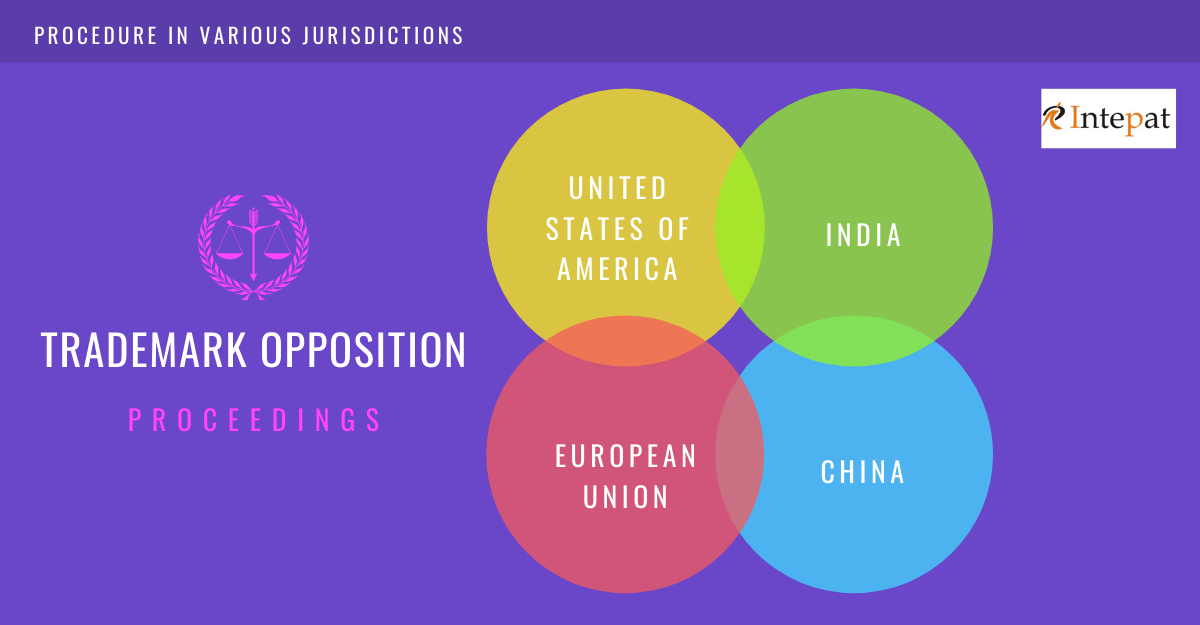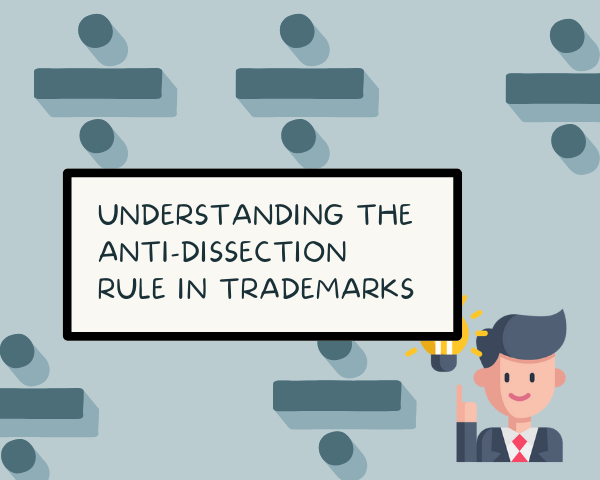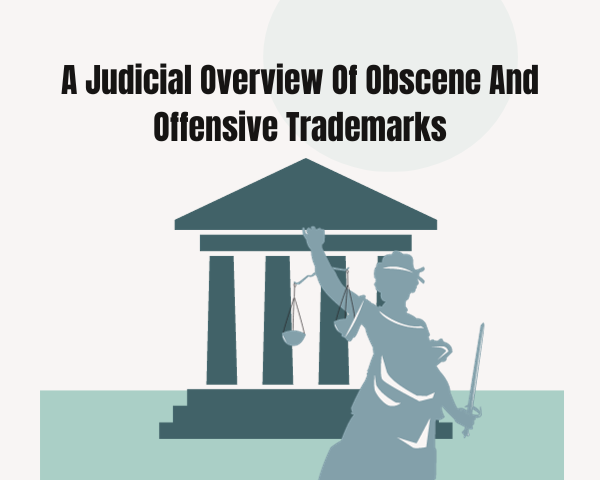Trademark opposition proceedings provide an opportunity to third parties to oppose the registration of a trademark on various grounds. Accordingly, any third party can view the trademark published in the journal and file a trademark opposition against it. The following article provides insight into the trademark opposition proceedings in various jurisdictions, such as the U.S.A., India, China, and the European Union.
UNITED STATES OF AMERICA
1. Stages of Trademark Opposition
The trademark is published for opposition in the United States Patent & Trademark Office (USPTO) Trademark Gazette, and whereafter, an opponent can file an opposition within 30 days. The time limit is extendable upon request. The Trademark Trial & Appellate Board (TTAB) of the USPTO is responsible for mediating disputes relating to trademark opposition & cancellation. However, TTAB’s decisions can only be limited to registration rights and not any other reliefs such as injunctions or damages.
After filing the opposition, a scheduling order is issued, which provides the entire schedule of the proceeding through trial to a decision based on the merits. The applicant has to file an answer to the opposition within 40 days of the notice of opposition. If the application does not provide the answer, a notice of default is issued to the applicant to show cause within 30 days. If the applicant still does not answer both notices, then a default judgment sustaining the opposition and refusing the registration of the opposed application is pronounced.
2. Fee
The opponent needs to pay $300 per class to file for an opposition. However, there are no fees required for filing requests to extend the opposition period.
3. Grounds
The United States has the following grounds for the opposition raised. The Lanham Act (U.S. Trademark Law) provides for the same.
Section 2
– If the mark contains an immoral or scandalous matter; or if the mark is deceptive and suggests a false connection to any other mark.
– Or the mark consists of or comprises the flag or coat of arms or other symbols of the United States, or of any state or municipality, or any foreign nation, or any simulation.
– A priority of rights and the likelihood of confusion; or when the mark is merely descriptive; deceptively misdescriptive geographically descriptive; geographically deceptively misdescriptive; generic; merely a surname; likely to cause trademark dilution etc.
Uruguay Round Agreements Act & Case Laws
-If the mark is a geographic indication which, if used on or in connection with wine or spirits, identifies a place other than the origin of the goods.
-If the applicant has committed fraud on the USPTO as was held In re Bose Corporation, 580 F.3d 1240, 91 USPQ2d 1938 (Fed. Cir. 2009).
4. Appeal
A party dissatisfied with the judgment of the TTAB can appeal either to the United States Court of Appeals for the Federal Circuit or have remedy by civil action in a United States district court.
INDIA
1. Stages of Trademark Opposition
Once the publication of trademarks proceeds in the trademark journal, any third party can file an opposition for any particular trademark within four months. After that, the applicant can file a response within two months from the date of notice of opposition. The inability to do so would render the trademark application abandoned. After filing the response, both parties are allowed to adduce evidence. Thereafter, the Registrar calls for a hearing and decides the case on merits.
2. Fee
The fee for opposing a mark by filing a notice of opposition on the prescribed (Form TM-O) is INR 2700.
3. Grounds
Section 9 & Section 11
– If the mark is devoid of any distinctive character and is not capable of distinguishing goods and services of one person from another.
– Or the mark designates the kind, quality, quantity, intended purpose, values, geographical origin, or if it consists exclusively of marks or indications, which have become customary in the current language or the bonafide and established practices of the trade.
-In case the mark is deceptive/ scandalous/ obscene or if it hurts religious sentiments.
– The mark is identical with or similar to an earlier trademark or if there is a likelihood of confusion.
European Union
1. Stages of Trademark Opposition
An applicant files a European Union trademark application, which is examined by the office. Upon approval, the publication of the mark proceeds in the European Union Trade Marks Bulletin. After that, there is a three-month time limit given to file a notice of opposition at the office, which is not extendable. A “cooling off” period provides to allow both parties to negotiate after the notice of opposition. Either party can opt out of the cooling-off period at any point in time.
2. Fee
The official opposition fee is €350.
3. Grounds
Article 8
-If it is identical to the earlier unregistered or registered trademark and the goods or services.
-If there is a likelihood of confusion. Further, the proprietor of an earlier non-registered right can prevent registration of a later EU trademark application if the proprietor has the right to prohibit the use of the application.
-If the mark is similar to and would affect the reputation of the earlier mark, then the proprietors of that mark can file an opposition. The beneficiaries under the protection of designations of origin and geographical indications under EU legislation or Member State laws can also oppose the registration of a later EU trademark application.
4. Appeal
Either party may appeal within two months of receiving the decision by filing a notice of appeal and paying the official appeal fee of €800.
CHINA
1. Stages of Trademark Opposition
The Chinese Trademark Office (CTMO) publishes all the preliminarily approved marks in the Trademark Gazette. After that, a person can file an opposition against a trademark within three months from the date of publication. After a lapse of three months without any opposition, the trademark registration certificate would proceed for registration. The CTMO gives the decision about the opposition of trademark registration within 2-3 years of the filing of the opposition.
2. Fee
The official fee for paper filing per class is 500 RMB, and e-filing per class is 450 RMB (To be opened).
3. Grounds
The Trademark Law of the People’s Republic of China provides the following grounds for filing an opposition:
Article 9
If a trademark does not have noticeable characteristics and is not distinguishable or if it conflicts with the legitimate rights of others, which were obtained earlier.
Article 10
– If it is identical with or similar to the State name, the national flag, emblem or anthem, the military flag, emblem or songs, or medals of the People’s Republic of China/ Central State organs/ foreign countries/ international inter-governmental organizations.
– Or similar to an official mark or inspection stamp that indicates control and guarantee. If it is detrimental to socialist ethics or customs or has other unwholesome influences.
Article 11
If it bears only the generic name, design, or model number of the goods concerned. If it directly indicates the quality, principal raw materials, function, use, weight, quantity, or other features of the good and lacks any distinctive character.
4. Appeal
However, Article 35 provides no obligation for the CTMO to wait for the response to the opposition notice. Regardless of the response, the office would take the decision post-completion of the investigation. However, an opportunity provides to appeal to the Trademark Review & Adjudication Board and, after that, to the Beijing IP court.




